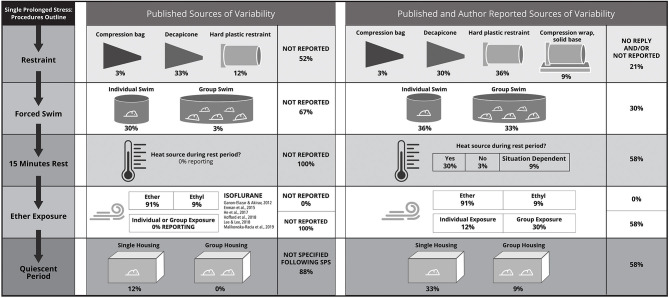Figure 2.
Each procedure required for single prolonged stress (SPS) is characterized by methodological variability; the chronological flow of SPS procedures detailed in the lefthand column: (i) restraint, (ii) forced swim, (iii) rest, (iv) exposure to diethyl ether vapors until the loss of consciousness, and (v) a quiescent period to consolidate effects of the SPS-stressors. Methodological variability is depicted based on published information from the 33 studies in the systematic review (central panel) and information from the systematic review expanded and refined through author contact (right-hand panel). Authors replied for only 14 studies, such that methods for only 42% of studies could be clarified. Details that were not published are denoted as “not reported” in the central panel, details that were not reported and/or could not be verified through author contact are listed in the right-hand panel as “no reply and/or not reported.” Details for the (iii) rest and (v) quiescent period are less frequently reported, but became clear sources of variability following author contact. The quiescent period was highlighted as a key source of variation by the expert panel (see section Methodological Considerations: Animal Housing). There are significant methodological differences for each SPS procedure that can contribute to lack of reproducibility, which will be subsequently described: (i) Based on published methods, restraint was most frequently applied using a decapicone, but on being directly queried, authors revealed that a number of studies used a custom-restraint type with a compression wrap and that hard-plastic restraints were used more frequently than a decapicones. This is in contrast to what was found when relying on published methods. This is critical given that animal safety considerations are specific to the restrainer type (Section Methodological Considerations: Single Prolonged Stress: Restraint Stress). (ii) The second SPS-stressor, forced swim, can be applied to individual rats or groups of rats, with author-reported group numbers varying from 3 to 8 age- and sex- matched conspecifics. This detail was omitted in the majority (67%) of published studies in the systematic review. (iii) During the 15-min rest phase, the use of heat to facilitate recovery was not reported in any of the published studies; however, this is a significant methodological consideration as heating enables rats to recover from the forced swim and before vapor exposure. Author replies indicate that a heating source was provided in at least 1 out of 3 studies or was “situation-dependent” (i.e., provided during winter but not summer); but the majority of authors failed to provide this information. Additional considerations for the rest phase include methods for drying rats following the forced swim, and whether rats are exposed to the heat source individually or in groups. (iv) There are several sources of methodological difference during vapor exposure including individual vs. group exposure and the type of anesthetic (diethyl ether, ethyl, or isoflurane). All published studies reported on type of vapor, but no study indicated whether rats were exposed to an anesthetic individually or in groups. Whether ethyl referred to diethyl ether could not be clarified by author contact. While isoflurane was not used in any of the systematic review studies, isoflurane is featured because it is occasionally substituted for ether because of logistical constraints arising from ether combustibility and personnel safety. However, isoflurane has distinct effects compared with diethyl ether and can introduce another source of variability if used in SPS (see section Methodological Considerations: Single Prolonged Stress: Ether). (v) During the quiescent period, the expert panel suggests that animals should be transferred to single-housing and “undisturbed” (see section Methodological Considerations: Animal Housing), and housing details should be reported to enhance the replicability and impact of SPS studies.

